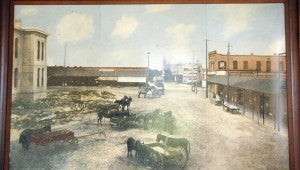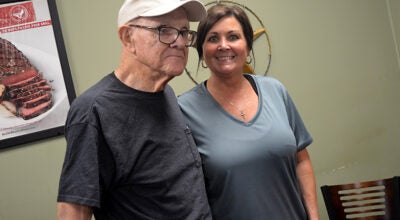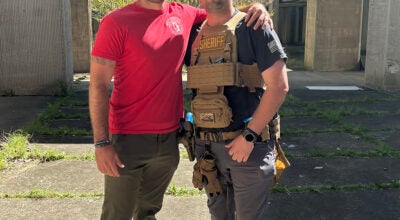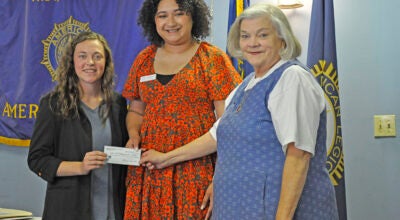1898 photo mural finds permanant home at JCA
Published 3:00 am Tuesday, August 4, 2015
The old adage, “Never look a gift horse in the mouth” is good advice. So, when Vicki Pritchett, Johnson Center for the Arts executive director, was contacted by Region’s Bank, asking if the arts center would be interested in a 9×6-foot photo mural of Downtown Troy in 1889, she didn’t hesitate.
She would find a place to for it.
“Of course, we wanted it, sight unseen,” Pritchett said. “The size of the mural was amazing. The date of the photograph, the subject and the fact that it was ‘color tinted’ by noted Troy photographer Holman Johnson made the offer intriguing.”
And, the photomural was no less intriguing when it arrived.
“Holman Johnson had the mural blown up from a very small photograph,” Pritchett said. “The mural is actually in three sections, but it’s so well done that it looks seamless. It is a wonderful depiction of Downtown Troy at the time the courthouse was under construction.
“We wanted the mural to have a permanent place at the Johnson Center, and it’s a perfect fit in the downstairs office where there is a lot of traffic. We could not be more appreciative of the gift or more pleased with its enhancement of the Johnson Center.”
Wiley White, Johnson Center development coordinator, said the mural is titled “City of Troy, Alabama 1898, South Side Square Looking East.”
“The scene is looking down Church Street, which is the side of the Square where Sips on the Square is located,” White said. “You can see a church in the distance, and someone said there was more than one church on the street. On the side of one building, there’s an advertisement mural for tobacco.
“The courthouse was under construction, and there are several horses and wagons on the street. Other than a few people on the walkways, there was not much activity when the photograph was taken.”
Jo Harvell, daughter of the late Holman Johnson, said her knowledge of the mural is limited primarily to what others know.
“The mural was enlarged from a very small black and white photograph,” she said. “Eastman Kodak did photograph enlargements back then and could have done the enlarged photographs for the mural.”
Harvell said she has no knowledge of the identity of the photographer.
“When my dad came home from the Navy, the Troy photographer, a Mr. Kennedy, had died, and he bought his negatives. Mr. Kennedy could have been the one who took the photograph, but I don’t know that.”
Harvell said her dad tinted the enlarged photograph for Farmers and Merchants bank.
“Bank then, the tinting of black and white photographs was popular,” she said. “My dad tinted photographs with oil paint, so I’m sure he used oil paint to tint the photograph of the City of Troy in 1898.”
Harvell said the church in the background was the second building that housed the Methodist Episcopal Church, which is now First United Methodist Church of Troy.
“In the photograph, the courthouse is under construction,” Harvell said. “There are several horse-pulled wagons in the street. It’s hard to tell whether the wagons are carrying construction materials or cotton.”
The mural depicts the early days of Troy and is an outstanding example of the tinting process, which was an art itself.
Holman Johnson was an amateur photographer before he went into the service.
“He had a sheet thrown over the door in the living room, and that’s where he would take photographs,” Harvell said. “He would develop the film in the kitchen.”
Johnson attempted to enlist in the Army the week after Christmas 1941 but was turned down because he had teeth that needed to be filled.
“My dad was a ham (amateur) radio operator and taught students at the college to operate ham radios until he was drafted,” Harvell said. “He was a photographer in the Navy. When he came home, he became the town photographer. He took photographs of people and he took photos of everything else. You might see him up a tree taking photographs. He took pictures for businesses and for the city. He would go up in airplanes to take pictures from that view. He took pictures of everything that was Troy.”
Although the mural of the City of Troy, Alabama 1898 is not a Holman Johnson photograph, it has his handiwork all over it.
“We are extremely pleased to have this photo mural on display at the Johnson Center,” Pritchett said. “We invite everyone to visit the Johnson Center to see the Biennial exhibit and the photo mural.”
The Johnson Center is open from 10 a.m. until 5 p.m. Wednesday through Friday and until 3 p.m. on Saturday. Admission is free.






